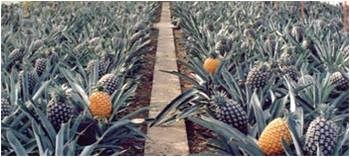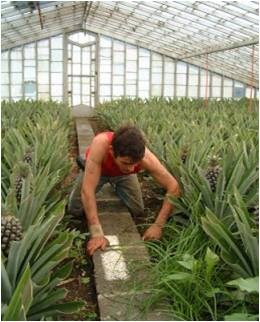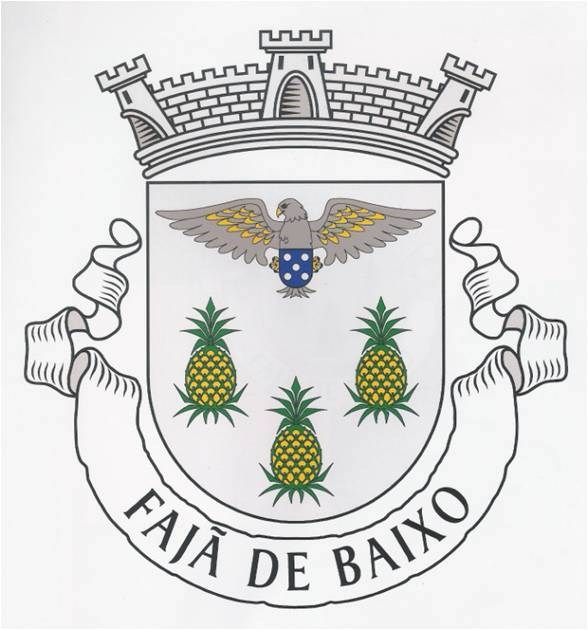|
ANANÁS DOS AÇORES



|
|
|
O Ananás dos Açores/S. Miguel (Ananas comosus L. Merril, variedade Cayene) é produzido em estufas de vidro utilizando técnicas de cultivo tradicionais: aplicação de "fumos" e utilização de "camas quentes" à base de matéria vegetal. Ao fim de um período de dois anos, desde a plantação até à colheita, obtém-se um fruto de qualidades ímpares de aroma e sabor. A cultura foi introduzida em S. Miguel por volta de 1840-50, sendo comercializado na Europa há mais de um século.
Fruto de forma cilíndrica, ligeiramente afusado, com casca laranja forte e polpa amarela. A polpa do ananás apresenta uma coloração amarela translúcida, um sabor agridoce sui generis e um aroma muito agradável.
Objeto de natural curiosidade da época, o ananás foi considerado "o Rei dos Frutos e o Fruto dos Reis", tendo-se cultivado em estufas nos Séculos XVII e XVIII como cultura experimental e curiosidade botânica ornamental. A introdução do ananás nos Açores, mais propriamente na ilha de S. Miguel, verificou-se em meados do século passado, por volta de 1848-1850, consequência do porfiado esforço do escritor António Feliciano de Castilho, que por ocasião do seu desterro em São Miguel escreveu um artigo em "O agricultor Micaelense", referindo o ananás como o "Rei da Fruta". Em 1864, é construída a primeira estufa de dimensão industrial com capacidade para 800 plantas, chegando a atingir na época áurea de cultura, um património de 4300 estufas de produção. Atendendo à reduzida produção (cerca de 1.900 toneladas), sobretudo às características técnicas e ao modo tradicional de cultivo, em estufas de vidro e em "camas quentes" à base de matéria vegetal, sem necessidade de recorrer a fertilizantes químicos e pesticidas, o Ananás de S. Miguel é considerado como fruto Rei.

|
|
|
|
O ananás é o fruto emblemático da ilha de São Miguel e, encontra-se presente na vida económica, política, social e cultural micaelense, tendo a sua fama extravasado a fronteira local.
FAJÃ DE BAIXO – CAPITAL DO ANANÁS
Das mais variadas formas, o ananás impõe-se. No turismo, a Fajã de Baixo é hoje obrigatoriamente um ponto de paragem para quem visita os Açores, pois é lá que se encontra uma emblemática instituição turística, como é o caso da plantação de ananases “A. Arruda”, onde é dado a conhecer ao visitante todas as fases da cultura do ananás em estufas de vidro, única no mundo e típica da Ilha de São Miguel, singularidade importante que deve ser objeto de preservação.

Num bonito prédio, instalado junto ao Solar da Família de Augusto Rebelo Arruda, para além da visita às estufas, os turistas são brindados com uma prova de licor de ananás, de receita tradicional, tendo para além disso oportunidade de adquirir ananases, doces, compotas e rebuçados de ananás, tudo de fabrico caseiro, a que juntaram agora o serviço de distribuição de sumo natural do fruto, feito na hora, bem como uma quantidade admirável do mais bonito e diverso artesanato.
Augusto Arruda, advogado de profissão, foi também produtor de ananás e um dos pioneiros do desenvolvimento turístico dos Açores. É caso para dizer-se que o seu sentido de prever o futuro, aqui ficou marcado, pois a dita propriedade sita à Abelheira, na Fajã de Baixo é hoje uma referência no turismo açoriano, ou melhor, cumpre o «sonho do Dr. Augusto Arruda de ligar o ananás micaelense ao turismo.»
Encontramos hoje o ananás representado na cerâmica regional, em porcelana importada e em peças de ourivesaria e joalharia.
As placas toponímicas da freguesia da Fajã de Baixo, produzidas em azulejaria regional micaelense, com os seus ananases pintados à mão, para além da beleza artística, são uma marca importante do ananás. Tal como a calçada tradicional portuguesa, da graciosa Rua Direita da Fajã de Baixo, que apresenta em grande profusão o ananás.

Por fim, na heráldica da Fajã de Baixo, com o seu Brasão, Bandeira e Selo, onde se lê:
«Escudo de prata, três ananases de ouro folhados e realçados de verde; em chefe, um açor de sua cor, segurando nas garras um escudete azul carregando de cinco besantes; coroa mural de prata de três torres; listel branco com a legenda a negro: “Fajã de Baixo”»
ENGLISH
|
AZOREAN PINEAPPLE
|
|
|
The Pineapple from Azores/S. Miguel (Ananas comosus L. Merrill , variety Cayene) is produced in glasshouses using traditional cultivation techniques : application of " smoke " and use of " hot beds " made of vegetal matter. After a period of two years from planting to harvest, we obtain a result of unique qualities of aroma and flavor. The crop was introduced in S. Miguel around 1840-50, being marketed in Europe for over a century.
Fruit in cylindrical shape, with bright orange skin and yellow flesh. The flesh of the pineapple has a translucent yellow color, one sui generis bittersweet taste and a very pleasant aroma.
Object of natural curiosity at the time, the pineapple was considered the "King of Fruits and the Fruit of Kings", having grown in greenhouses in the seventeenth and eighteenth centuries as an experimental crop and ornamental botanical curiosity. The introduction of pineapple in the Azores, more specifically at the island of São Miguel, occurred in the last century, around 1848-1850, in result of the effort of the writer Antonio Feliciano de Castilho, who on the occasion of his banishment in São Miguel, wrote an article on "The São Miguel farmer" referring pineapple as the "King of Fruit ". In 1864, was built the first industrial-size greenhouse with a capacity of 800 plants, reaching the golden age of culture, a heritage of 4300 production greenhouses. Given the limited production (about 1.900 tons), mainly due to the technical characteristics and the traditional way of cultivation in glasshouses and "hot beds" made of vegetal matter, without the need for chemical fertilizers and pesticides, the St. Michael’s Pineapple is considered as the fruit king.
|
|
|
|
The pineapple is the emblematic fruit of the island of São Miguel and is present in its economic, political, social and cultural way of life, with its fame surpassing the local border.
FAJÃ DE BAIXO – CAPITAL OF PINEAPPLE
In the most varied forms, the pineapple is essential. In tourism, the Fajã de Baixo is now an obligatory stopping point for anyone visiting the Azores, for there is an iconic tourist institution, such as the planting of pineapples "A. Arruda" which is given to show to the visitor all phases of the culture of the pineapple in glass greenhouses, unique in the world and typical of the island of São Miguel, importantly uniqueness that should be the object of preservation.
In a beautiful building, located next to the Augusto Rebelo Arruda’s family house, beyond from visiting the greenhouses, tourists are invited to a traditional recipe’s pineapple liqueur taste, in addition you have the opportunity to purchase pineapples, jams and candies, all home-made, you can also try the pineapple natural juice, made to order, as well as an admirable amount of the most beautiful and diverse craft.
Augusto Arruda, a lawyer by profession, was also producer of pineapple and a pioneer of tourism development in the Azores. We can say that his sense of predicting the future, was marked here as his property next to Abelheira, in Faja de Baixo is today a reference in the Azores tourism, and fulfills Dr. Augusto Arruda dream “connecting the Azorean pineapple with tourism”.
Nowadays, pineapple is represented in regional ceramic, imported porcelain and jewelry.
The signposts of Faja de Baixo, made of regional tile produced in São Miguel, with its hand-painted pineapples, in addition to artistic beauty, are a major brand of pineapple. The traditional Portuguese pavement, in the graceful street “Rua Direita da Faja de Baixo, is also representative to the pineapple.
Finally, in Faja de Baixo heraldry, with his Coat of Arms, Flag and Seal, this reads:
«Silver Shield, three pineapples puffs of gold and highlighted in green; in chief, a goshawk of its color , holding in the claws a blue escutcheon carrying five bezants; Silver mural crown with three towers; White span with the legend in black: "Fajã de Baixo"»